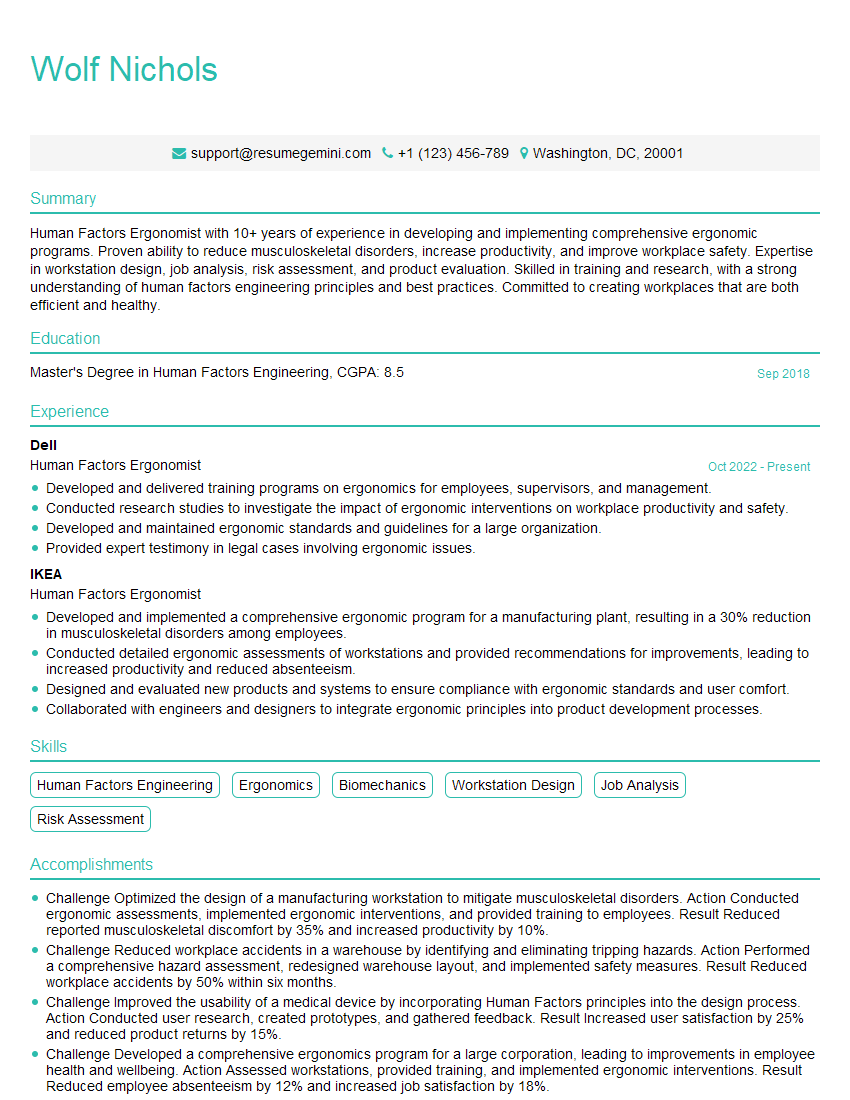Are you a seasoned Human Factors Ergonomist seeking a new career path? Discover our professionally built Human Factors Ergonomist Resume Template. This time-saving tool provides a solid foundation for your job search. Simply click “Edit Resume” to customize it with your unique experiences and achievements. Customize fonts and colors to match your personal style and increase your chances of landing your dream job. Explore more Resume Templates for additional options.

Wolf Nichols
Human Factors Ergonomist
Summary
Human Factors Ergonomist with 10+ years of experience in developing and implementing comprehensive ergonomic programs. Proven ability to reduce musculoskeletal disorders, increase productivity, and improve workplace safety. Expertise in workstation design, job analysis, risk assessment, and product evaluation. Skilled in training and research, with a strong understanding of human factors engineering principles and best practices. Committed to creating workplaces that are both efficient and healthy.
Education
Master’s Degree in Human Factors Engineering
September 2018
Skills
- Human Factors Engineering
- Ergonomics
- Biomechanics
- Workstation Design
- Job Analysis
- Risk Assessment
Work Experience
Human Factors Ergonomist
- Developed and delivered training programs on ergonomics for employees, supervisors, and management.
- Conducted research studies to investigate the impact of ergonomic interventions on workplace productivity and safety.
- Developed and maintained ergonomic standards and guidelines for a large organization.
- Provided expert testimony in legal cases involving ergonomic issues.
Human Factors Ergonomist
- Developed and implemented a comprehensive ergonomic program for a manufacturing plant, resulting in a 30% reduction in musculoskeletal disorders among employees.
- Conducted detailed ergonomic assessments of workstations and provided recommendations for improvements, leading to increased productivity and reduced absenteeism.
- Designed and evaluated new products and systems to ensure compliance with ergonomic standards and user comfort.
- Collaborated with engineers and designers to integrate ergonomic principles into product development processes.
Accomplishments
- Challenge Optimized the design of a manufacturing workstation to mitigate musculoskeletal disorders. Action Conducted ergonomic assessments, implemented ergonomic interventions, and provided training to employees. Result Reduced reported musculoskeletal discomfort by 35% and increased productivity by 10%.
- Challenge Reduced workplace accidents in a warehouse by identifying and eliminating tripping hazards. Action Performed a comprehensive hazard assessment, redesigned warehouse layout, and implemented safety measures. Result Reduced workplace accidents by 50% within six months.
- Challenge Improved the usability of a medical device by incorporating Human Factors principles into the design process. Action Conducted user research, created prototypes, and gathered feedback. Result Increased user satisfaction by 25% and reduced product returns by 15%.
- Challenge Developed a comprehensive ergonomics program for a large corporation, leading to improvements in employee health and wellbeing. Action Assessed workstations, provided training, and implemented ergonomic interventions. Result Reduced employee absenteeism by 12% and increased job satisfaction by 18%.
- Challenge Designed and implemented a Human Factors Engineering course that met the industrys latest standards. Action Developed curriculum, incorporated handson activities, and obtained accreditation. Result Graduated students with the knowledge and skills to succeed in the field.
Awards
- Recognized with Excellence Award for outstanding contributions to the field of Human Factors Ergonomics, leading to improved workplace safety and productivity.
- Awarded Research Grant for investigating the impact of virtual reality training on reducing workplace injuries in the construction industry.
- Honored with the Young Professional Award for significant contributions to the advancement of Human Factors Ergonomics in the automotive industry.
- Nominated for the Best Paper Award at the International Human Factors and Ergonomics Society (HFES) Annual Conference for research on the influence of fatigue on cognitive performance.
Certificates
- Certified Professional Ergonomist (CPE)
- Board Certified Human Factors Professional (HFCP)
- Certified Work Place Ergonomics Professional (CWEP)
- Certified Disability Management Specialist (CDMS)
Career Expert Tips:
- Select the ideal resume template to showcase your professional experience effectively.
- Master the art of resume writing to highlight your unique qualifications and achievements.
- Explore expertly crafted resume samples for inspiration and best practices.
- Build your best resume for free this new year with ResumeGemini. Enjoy exclusive discounts on ATS optimized resume templates.
How To Write Resume For Human Factors Ergonomist
- Quantify your accomplishments with specific metrics to demonstrate the impact of your work.
- Highlight your expertise in human factors engineering principles and research methods.
- Showcase your ability to communicate complex technical concepts to non-technical audiences.
- Emphasize your commitment to workplace safety and employee well-being.
Essential Experience Highlights for a Strong Human Factors Ergonomist Resume
- Develop and implement ergonomic programs to prevent and reduce musculoskeletal disorders.
- Conduct detailed ergonomic assessments of workstations, tools, and equipment.
- Provide recommendations for ergonomic improvements to increase productivity and reduce absenteeism.
- Design and evaluate new products and systems to ensure compliance with ergonomic standards.
- Collaborate with engineers and designers to integrate ergonomic principles into product development processes.
- Develop and deliver training programs on ergonomics for employees, supervisors, and management.
Frequently Asked Questions (FAQ’s) For Human Factors Ergonomist
What is the role of a Human Factors Ergonomist?
Human Factors Ergonomists apply principles of human factors engineering to design and evaluate workplaces, products, and systems to ensure they are safe, efficient, and comfortable for people to use.
What are the benefits of working as a Human Factors Ergonomist?
Human Factors Ergonomists play a vital role in improving workplace safety, productivity, and employee well-being. They can help organizations reduce costs associated with musculoskeletal disorders, absenteeism, and accidents.
What skills are required to be a successful Human Factors Ergonomist?
Successful Human Factors Ergonomists have a strong understanding of human factors engineering principles, research methods, and workplace safety regulations. They are also skilled in communication, problem-solving, and teamwork.
What is the job outlook for Human Factors Ergonomists?
The job outlook for Human Factors Ergonomists is expected to grow in the coming years due to the increasing demand for workplace safety and efficiency.
What are the career advancement opportunities for Human Factors Ergonomists?
Human Factors Ergonomists can advance their careers by taking on leadership roles, specializing in a particular area of ergonomics, or pursuing further education.